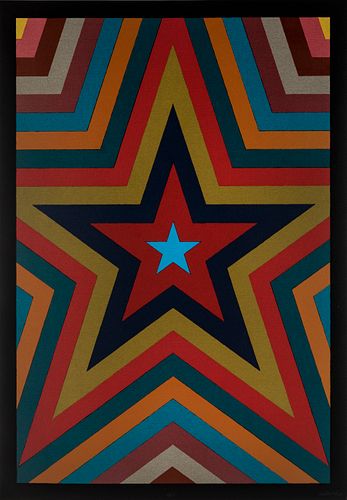SOL LEWITT (United States, 1928 - 2007). Untitled, from the Olympic Centennial Suite, 1992. Silkscreen on 270 gr Velin d'Arches paper, 109/250. Signed
Lot 3
About Seller
Setdart Auction House
Carrer Aragó 346
Barcelona
Spain
Setdart Subastas was born in 2004 and is currently the first online art auction in Spain with solidity, prestige and reliability guaranteed by our more than 60,000 users. Setdart has a young, dynamic and enterprising team ready to successfully manage the purchase and sale of art works through custom...Read more
Categories
Estimate:
$1,000 - $1,200
Absentee vs Live bid
Two ways to bid:
- Leave a max absentee bid and the platform will bid on your behalf up to your maximum bid during the live auction.
- Bid live during the auction and your bids will be submitted real-time to the auctioneer.
Bid Increments
| Price | Bid Increment |
|---|---|
| $0 | $10 |
| $200 | $25 |
| $500 | $50 |
| $1,000 | $100 |
| $3,000 | $200 |
| $5,000 | $500 |
| $10,000 | $1,000 |
| $20,000 | $2,000 |
| $50,000 | $5,000 |
About Auction
By Setdart Auction House
Jun 17, 2021
Set Reminder
2021-06-17 06:15:00
2021-06-17 06:15:00
America/New_York
Bidsquare
Bidsquare : 19th & 20th Century Contemporary Art - Select Lots
https://www.bidsquare.com/auctions/setdart-auction-house/19th-20th-century-contemporary-art---select-lots-7081
Setdart Auction House sofia@setdart.com
Setdart Auction House sofia@setdart.com
- Lot Description
SOL LEWITT (United States, 1928 - 2007). Untitled, from the Olympic Centennial Suite, 1992. Silkscreen on 270 gr Velin d'Arches paper, 109/250. Signed and justified Measurements: 90 x 63 cm. The Olympic Suite is composed of fifty lithographs and serigraphs chosen to represent various contemporary artistic trends. It was published to commemorate the first centenary of modern Olympism. The chosen artists work in very diverse movements and styles, from the hyperrealism of Antonio López to the abstraction of Sol Lewitt, passing through abstract expressionism, the geometrism of Arden Quin, conceptual art, pop art, the new realism of Baldaccini and Rotella, or the new fauvism of Dokoupil, among others. Among the artists represented there are creators of great international projection, widely recognized by critics. An artist linked to several movements, including conceptual and minimal art, Sol LeWitt expressed himself mainly through painting, drawing, photography and structures. Born into a Jewish family of Russian immigrants, after receiving a BFA from Syracuse University in 1949 he began a series of trips through Europe, where he was influenced by the great masters of painting. Settling in New York in the fifties, he focused his interest in graphic design, working for Seventeen Magazine. During the following decade the artist worked at the MoMA in New York, another experience that would mark the development of his work. During these years, LeWitt became one of the main representatives of conceptual art, which emphasizes that the idea, and not its physical form, is fundamental. He was one of the pioneers of this movement, as well as one of its most prominent theoreticians, and his work has also been related to minimalism. From 1965 LeWitt will be the subject of hundreds of solo exhibitions in museums and galleries around the world. His works include two- and three-dimensional works, from wall paintings (more than 1,200) to photographs, drawings and sculptures of all kinds, including towers, pyramids, geometric forms and progressions. Sol LeWitt frequently used open, modular structures based on the cube, a key form in the development of his language. In 1978, the Museum of Modern Art in New York dedicated his first retrospective exhibition to him. LeWitt is currently represented in that museum, as well as in the Guggenheim in New York and Bilbao, the Kunstmuseum in Basel, the Palazzo Forti in Verona, the SMAK in Ghent, the Tate Gallery in London, the Hirshhorn Museum and Sculpture Garden and the National Gallery in Washington, the Metropolitan in New York and the National Gallery of Australia, among many others.
- Shipping Info
-
In-house shipping available. Please inquire at admin@setdart.com.
-
- Buyer's Premium



 EUR
EUR CAD
CAD AUD
AUD GBP
GBP MXN
MXN HKD
HKD CNY
CNY MYR
MYR SEK
SEK SGD
SGD CHF
CHF THB
THB












